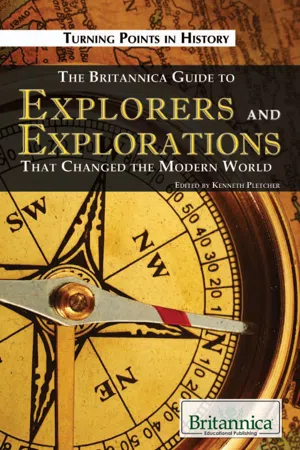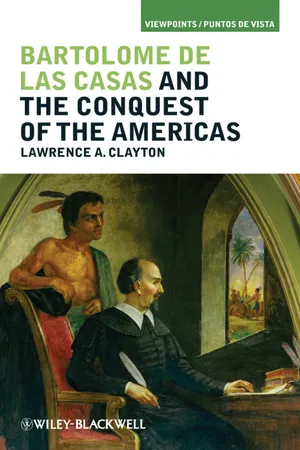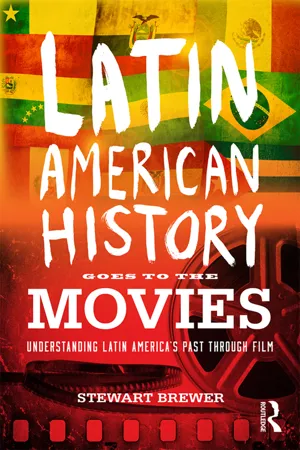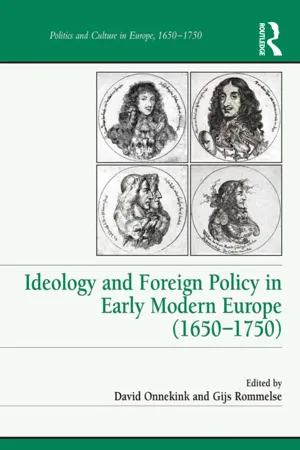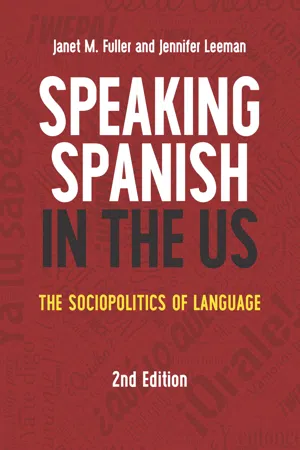History
Spanish Exploration
Spanish exploration refers to the period of exploration and colonization by Spain in the 15th to 17th centuries. Spanish explorers such as Christopher Columbus, Hernán Cortés, and Francisco Pizarro played significant roles in discovering and conquering new territories in the Americas. This exploration led to the establishment of Spanish colonies and the spread of Spanish culture, language, and influence in the New World.
Written by Perlego with AI-assistance
Related key terms
6 Key excerpts on "Spanish Exploration"
- Britannica Educational Publishing, Kenneth Pletcher(Authors)
- 2009(Publication Date)
- Britannica Educational Publishing(Publisher)
C hapter 3:Colonial Exploration of the New WorldT he age of modern colonialism began about 1500, following the European discoveries of a sea route around Africa’s southern coast (1488) and of America (1492). With these events sea power shifted from the Mediterranean to the Atlantic and to the countries that developed their maritime power. By discovery, conquest, and settlement, these nations expanded and colonized throughout the world, spreading European institutions and culture.SPAIN: THE CONQUESTS
Only gradually did the Spaniards realize the possibilities of America. They had completed the occupation of the larger West Indian islands by 1512, though they largely ignored the smaller ones, to their ultimate regret. Thus far they had found lands nearly empty of treasure, populated by inhabitants who died off rapidly on contact with Europeans. In 1508 an expedition did leave Hispaniola to colonize the mainland, and, after hardship and decimation, the remnant settled at Darién on the Isthmus of Panama, from which in 1513 Vasco Núñez de Balboa made his famous march to the Pacific. On the Isthmus the Spaniards heard garbled reports of the wealth and splendour of Inca Peru. Balboa was succeeded (and judicially murdered) by Pedrarias Dávila, who turned his attention to Central America and founded Nicaragua.Expeditions sent by Diego Velázquez, governor of Cuba, made contact with the decayed Mayan civilization of Yucatán and brought news of the cities and precious metals of Aztec Mexico. Hernán Cortés entered Mexico from Cuba in 1519 and spent two years overthrowing the Aztec confederation, which dominated Mexico’s civilized heartland. The Spaniards used firearms effectively but did most of their fighting with pikes and blades, aided by numerous Indian allies who hated the dominant Aztecs. The conquest of Aztec Mexico led directly to that of Guatemala and about half of Yucatán, whose geography and warlike inhabitants slowed Spanish progress.- Lawrence A. Clayton, Lawrence A. Clayton(Authors)
- 2010(Publication Date)
- Wiley-Blackwell(Publisher)
3 Columbus sailed for a number of years in the service of Portugal into the ports and harbors of the Atlantic—all the way from Iceland to Africa—during this period of expansion. This move from the relative provincialism and insularity of the European medieval period into a dynamic epoch of exploration, discovery, and trade has usually been labeled the era of “early modern Europe.” The stage for the emergence of early modern Portugal or Spain was the Atlantic world, another modern paradigm which emphasizes the growing connectivity among islands and continents bordering the great Atlantic Ocean. And Columbus was the quintessential navigator, merchant, explorer, and discoverer of this age.In his life we see converging all of these different elements that contributed to the making of early modern Spain. Among these were the mercantile tradition, the technological advantages in sailing and navigation, the powerful religious dimension, and, perhaps underscoring them all, the entrepreneurial spirit of change that drove these communities of navigators, merchant princes, bankers, and kings and queens to push beyond the old geographical and cultural boundaries of Europe into the Atlantic world.The religious fervor of the Reconquest, seen as carrying over into and deeply influencing the later conquest of the Americas, has long received the most attention by historians. In a spate of religious zealotry, Jews were expelled (unless they chose to convert) from Spain in 1492, and ten years later all Moors were forced to convert to Christianity or choose exile, the same as the Jews. Ethnically and racially this was an intolerant society. The Spanish Inquisition was established precisely at that time to ensure Christian orthodoxy and stamp out heresy and apostasy.Columbus shared this religious passion with his sponsors, especially the pious Queen Isabel. He promised to turn over much of what he stood to earn by his voyages to the Queen and the Church for the restoration of Christianity in the Holy Land and to crush the infidels. These were grandiose visions when one considers the boundaries of the world inhabited by Columbus, until one recalls that in his commercial voyages in the service of Portugal, he already had reached probably as far north as Iceland and had visited the African coast far to the south before taking off on his voyage of discovery in August, 1492. Columbus, the religious zealot, was also Columbus the merchant and experienced explorer. Other events also drove Europeans farther into the Atlantic world.- No longer available |Learn more
Latin American History Goes to the Movies
Understanding Latin America's Past through Film
- Stewart Brewer(Author)
- 2015(Publication Date)
- Routledge(Publisher)
Wealthy and not-so-wealthy noblemen sought their fortune in the New World. Second sons who did not stand to inherit looked to the New World as a place of new beginnings and limited social hindrances. Clergymen saw the New World as a land ripe for proselytizing, a continent filled with vast groups of people in need of the gospel of Jesus Christ. But whatever their reasons, Spaniards, Portuguese, and other Europeans flocked to the Americas in ever-increasing numbers, searching for a new life in the New World. Of course, when the peoples and cultures of the Old World encountered and interacted with those of the New World, conflict was a frequent outcome. And, because of certain advantages discussed below, the European explorers and conquistadores managed to subdue countless numbers of Amerindians, while untold hundreds of thousands died from disease, warfare, and poverty. The Conquest of Latin America The conquest of Latin America took place throughout the sixteenth century and even into the seventeenth century in some locations such as the Maya highlands. The term “conquest” is habitually problematic because the overthrow of Latin America involved much more than just the military subjugation of the various Indian populations in the Americas. In addition to military strength, the conquest also involved an ecclesiastical transformation, as Indian religions were supplanted by Roman Catholicism; Indian social networks were disrupted by the Spanish Caste System; and Indian economic and agricultural practices were transformed by Spain’s desires for silver and gold that they brought with them across the Atlantic Ocean. Nevertheless, all of these aspects of subjugation began in a few specific locations. The Spanish conquest of two major Amerindian civilizations of Latin America, the Aztecs of central Mexico, and the Inca of the Andes, set in motion Spain’s eventual hegemony over most of the Western Hemisphere - eBook - ePub
Western Civilization: A Global and Comparative Approach
Volume I: To 1715
- Kenneth L. Campbell(Author)
- 2014(Publication Date)
- Routledge(Publisher)
The Age of European Expansion, ca. 1550–1650In the second half of the sixteenth century, the rivalry between Catholicism and Protestantism extended overseas. In the initial push toward overseas expansion, both the Portuguese and the Spanish officially proclaimed the spread of Christianity their top priority. A dozen members each from the Franciscan and Dominican orders followed Cortés to Mexico in the 1520s intent on ensuring the conversion of the Indians and defending them from oppressive treatment. With the spread of the Reformation in Europe, Catholic orders made a great effort to increase the number of Catholics worldwide. The Jesuits concentrated their efforts on Asia precisely because of the large population there that offered the possibility of increasing the numerical superiority of Catholics over Protestants. Protestant missionary efforts did not approach the scale of the Catholics in this period, partly because Protestants had their hands full defending their interests in Europe and in part because they lacked the religious orders that played such an important role in Catholic missions.However, the continuation of European exploration and expansion after 1550 was mainly carried out under the auspices of the national states for political and economic reasons. The English and the French focused their efforts primarily upon North America beginning in the 1530s and intensifying around the beginning of the seventeenth century, though both hoped to find new passages to the East with an eye toward the lucrative spice trade. In the early seventeenth century the newly independent Dutch succeeded in gaining a significant portion of the spice trade and emerged as a commercial power in the East Indies. European influence was felt throughout the Americas and significant parts of Africa and Asia, including increased contact with China, India, and Japan.Japan provides a good basis for cross-cultural comparisons with Europe during this period. Contemporary developments in Japan greatly affected that country’s response to Western contact. Japanese society was undergoing considerable change at the time when it first came into contact with Europeans. The case of Japan illustrates the ways in which the response to European contact and cross-cultural interaction depended largely on internal factors within an individual society. The internal changes in sixteenth-century Japan also provide a useful basis of comparison with the changes experienced in European society, politics, and the economy during the same period. In the century following 1550, a world network of trade developed and patterns of cross-cultural interaction emerged that significantly influenced the future of both the West and all areas with which it came into contact. This chapter tells the story of those influences. - Gijs Rommelse, David Onnekink(Authors)
- 2016(Publication Date)
- Routledge(Publisher)
From the fifteenth century onwards this imperialism was aimed at achieving an imperial Spain shaped as a nation in the applied ethnic sense, with a more geographical than political meaning in the eyes of Europe. John Elliott believed that the imperial phase of Spain was circumscribed to the period beginning in 1469, with the marriage between Ferdinand of Aragon and Isabella of Castile, and ending in 1716 with the enactment of the Decree of Nueva Planta, and the start of the absolutist centralism implanted by the House of Bourbon, which also brought the end of regional political powers. 5 Henry Kamen extended this second phase to the nineteenth century, and considers the Spanish effort as the first modern globalization; in spite of the fact that the empire was not directed by anyone, surprisingly, it performed very well. A similar interpretation was offered by Anthony Pagden when he analysed the source of the ideology of the Spanish empire within the general context of the evolution of other European empires and defined a chronology which extends from the first of Columbus’s voyages to the final defeat of the Carlist armies in South America in 1830. This was not an empire from the politico-administrative viewpoint; it was more a kind of somewhat special ‘confederate empire’, although it was not the first of this type, since similar conglomerates had existed in antiquity. 6 With regards to its political constitution, the Hispanic Monarchy opted for the court as a means of connection, given the increase in the number of kingdoms due to inheritance and dynastic privileges, annexation or conquest. Such a political configuration encouraged a number of characteristics different from those traditionally explained by historians, which were based on structures and on a progressive and rational evolution towards the formation of the state- eBook - ePub
Speaking Spanish in the US
The Sociopolitics of Language
- Janet M. Fuller, Jennifer Leeman(Authors)
- 2020(Publication Date)
- Multilingual Matters(Publisher)
In the 16th century, Spanish arrived in what is now the US as a language of colonizers, but over the course of the 19th century it increasingly became a colonized language. As such, Spanish became subordinated to English in language ideologies (discussed in the next chapter) as well as language policies (discussed in Chapter 8). Of course, these ideologies and policies were not just about language per se; rather, they were part of a broader subordination of Spanish-speakers in which language was a tool for the exercise of power. Just as the racialization of African and Native peoples can be traced to colonial encounters and the slave trade, the Othering of Spanish-speakers and Latinxs is rooted in the period leading up to and following US territorial expansion (Vélez-Ibáñez, 2017). Black and White Legends, Hispanophilia and Oñate’s Foot At the outset of this chapter we noted that the historical presence of Spanish in the US is often overlooked. But while the periods of Spanish and Mexican rule are often omitted or downplayed in traditional accounts of US history, this does not mean that they are universally ignored. In this section we discuss the portrayal of the Spanish history of the Southwest, and of New Mexico in particular. History is never just a neutral description of the past, and historical accounts of the US’ Spanish colonial past are no exception. As we’ll show, these accounts are tied up with various political, economic and social interests, as well as with debates over the construction and representation of ethnoracial and national identities. The 16th and 17th centuries were a period of intense competition among European imperial powers and religious institutions for dominion in the Americas and around the globe. In addition to military force, imperial rivals also used political and religious propaganda to convince their subjects of the righteousness of their efforts
Index pages curate the most relevant extracts from our library of academic textbooks. They’ve been created using an in-house natural language model (NLM), each adding context and meaning to key research topics.
